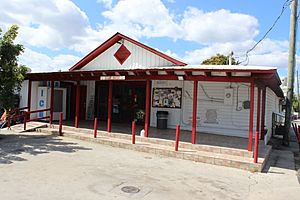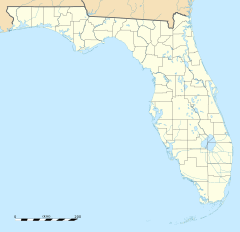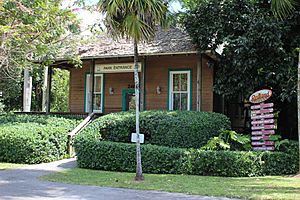Redland, Florida facts for kids
Quick facts for kids
Redland, Florida
|
|
|---|---|

The 1912 Pioneer Guild Hall in Redland, now the Redland Grocery
|
|
| Country | United States |
| State | Florida |
| County | Miami-Dade |
| Elevation | 7 ft (2 m) |
| Population
(2010)
|
|
| • Total | 10,138 |
| Time zone | UTC-5 (Eastern (EST)) |
| • Summer (DST) | UTC-4 (EDT) |
| Area code(s) | 305, 786 |
| FIPS code | 12-36100 |
| GNIS feature ID | 0285050 |
Redland is a special place in Miami-Dade County, Florida. It's an "unincorporated community," which means it's not officially a city or town with its own local government. Instead, it's governed by the county.
Redland is famous for its large farming areas. It's located about 20 miles (32 km) southwest of downtown Miami. What makes it unique is that it's a big farming belt right next to one of the largest cities in the United States!
The area gets its name from the red clay soil found there. This soil covers a layer of limestone rock. Redland is known for growing many kinds of tropical fruits. Many of these fruits can't be grown anywhere else in the continental United States. You'll also find many plant nurseries that grow beautiful ornamental plants.
When you visit Redland, you might see fields where you can pick your own fruit. There are also old coral rock walls and historic wooden homes from the early settlers.
Contents
What's in a Name? The Story of Redland
The name "Redland" comes from the unique red soil found in the area. For a long time in the early 1900s, a bigger region was called the "Redland District." This district included several communities like Homestead and Florida City.
The specific community of Redland was located west of Krome Avenue, south to Biscayne Drive, and north to Eureka Drive. The name "Redland" (singular) was supposedly used to avoid confusion with the city of Redlands, California.
Early Attempts to Become a Town
In 1910, a smaller part of Redland briefly became an official town, but it didn't last long. Later, in the 1920s, people tried again to make Redland a town. They wanted it to be about six square miles. However, residents couldn't agree on the exact borders, so the plan didn't happen.
Today, people use "Redland," "the Redlands," and "the Redland" to talk about the area. "Redland" is usually the more formal way to say it.
A Look Back: Redland's History
Redland began to grow in the early 1900s. This was when Henry Flagler was building his railroad. Early settlers found a special way to prepare the tough soil for farming, called "scarifying" or "plow-breaking."
This new farming method helped the land become a major source of winter crops for America. It was even called the "garden capital of the world." The main part of the community was near Redland Road and Bauer Drive.
You can find many historic markers in the area. These markers tell stories about important places and events from Redland's past.
Redland's Farming and Economy
Redland has a tropical climate, which is perfect for growing many unique fruits. These fruits are not grown commercially anywhere else in the continental United States. Some examples include:
- mango
- avocado
- guava
- passion fruit
- carambola (star fruit)
- lychee
- jack fruit
- canistel
- sapodilla
- longan
- mamey sapote
- black sapote (chocolate pudding fruit)
- miracle fruit
- jaboticaba
- cecropia (snake fingers)
- coffee beans
Avocados are the biggest crop grown here, covering nearly 8,000 acres (3,237 hectares). Today, farmers in Redland come from many backgrounds, including Cuban-American and Asian-American families. There are also people who farm as a hobby and those involved in the farm-to-table movement.
The Fruit & Spice Park
The Fruit & Spice Park is a popular attraction in Redland. It's a 37-acre (15-hectare) park run by the county. Here, you can try samples of almost all the tropical fruits grown in the area. The park has over 150 types of mango and 70 kinds of bananas!
The original Redland Schoolhouse, built in 1906, was once the entrance to the park. It was destroyed by Hurricane Andrew, but a new building that looks just like it was built in its place. The park often hosts festivals, events, and community meetings, just like the old Pioneer Guild Hall and Redland Farm Life School used to.
Orchids and Other Plants
Redland is also home to many nurseries that grow beautiful orchids and other ornamental plants. The Redland International Orchid Festival is held at the Fruit & Spice Park every May. It's the largest annual orchid show in the United States!
Protecting Redland's Farmland
Most of Redland is outside the "urban development boundary" (UDB). This boundary was set up by Miami-Dade County to control where cities can grow. Because of this, houses built in Redland must be on at least 5 acres (2 hectares) of land. This rule helps protect the farming areas.
Some farmers with very large land areas have wanted to expand the UDB. They argue that limiting new buildings could lower land prices. However, smaller farmers, who own 5-acre lots and are more numerous, have successfully fought to keep Redland as farmland.
People in Redland have even thought about becoming an official town again. This would help them protect their area from urban growth and stop nearby cities from taking over parts of Redland.
Changes in the Landscape
Even with efforts to protect it, Redland's historic and rural feel has changed over time. Some old homes, which were not protected as historic sites, have been torn down. For example, the 1905 Kosel homestead and the 1926 Howard Schaff residence were both demolished.
Only two buildings in Redland are officially listed on the National Register of Historic Places: the William Anderson General Merchandise Store and the Silver Palm Schoolhouse.
Also, Krome Avenue, a main road through Redland, is being widened to four lanes. This project has already caused some local businesses to close and will likely change the rural character of the community even more.
Learning in Redland: Schools
Miami-Dade County Public Schools manages the public schools in Redland.
High Schools
- South Dade High School
Middle Schools
- Redland Middle School
- South Dade Middle School
Elementary Schools
- Redland Elementary School
- Avocado Elementary School
Private Schools
- Redland Christian Academy (Pre-Kindergarten to 12th grade)
- Colonial Christian School (Pre-Kindergarten to 12th grade)
Fun Places to Visit in Redland
- Monkey Jungle: A unique park where monkeys roam freely.
- Fruit & Spice Park: A park where you can explore and taste tropical fruits.
- William Anderson General Merchandise Store: A historic store.
- Silver Palm Schoolhouse: A historic one-room schoolhouse.
- Redland Farm Life School: An important historic school building.
Images for kids






